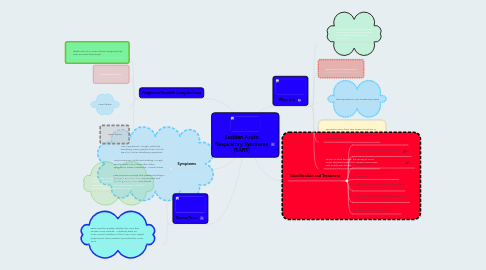Sudden Acute Respiratory Syndrome (SARS)
by Travis Kimberling

1. Symptoms
1.1. Main Symptoms: Cough, Difficulty breathing, Fever greater than 100.4°F (38.0°C), Other breathing symptoms
1.2. Most Common: Chills and shaking, Cough, usually starts 2 to 3 days after other symptoms, Fever, Headache, Muscle aches
1.3. Less Common:Cough that produces phlegm (sputum), Diarrhea Dizziness Nausea and vomiting Runny nose Sore throat
2. Exams/Tests
2.1. Tests used to diagnose SARS might include: Arterial blood tests, Blood clotting tests, Blood chemistry tests, Chest x-ray or chest CT scan, Complete blood count (CBC)
2.2. Tests used to quickly identify the virus that causes SARS include: Antibody tests for SARS, Direct isolation of the SARS virus, Rapid polymerase chain reaction (PCR) test for SARS virus
3. Prognosis/Possible Complications
3.1. death rate of 9-12% in those diagnosed (pt over 65 more than 50%)
3.2. Respiratory failure
3.3. Liver failure
3.4. Heart failure
4. What it is
4.1. febrile, severe respiratory illness caused by a coronavirus, called SARS-associated coronavirus (SARS-CoV)
4.2. serious form of pneumonia
4.3. first reported in Asia in February 2003
4.4. spread to more than two dozen countries in North America, South America, Europe, and Asia before the SARS global outbreak of 2003 was contained
4.5. winter of 2002 through the spring of 2003, WHO received reports of >8,000 SARS cases and nearly 800 deaths
5. Identification and Treatment
5.1. based on clinical and epidemiological findings
5.2. fever and unexplained lower respiratory symptoms in absence of pneumonia
5.3. direct person to person contact with SARS infected patient
5.4. Antibiotics to treat bacteria that cause pneumonia
5.5. Antiviral medicines (although how well they work for SARS is unknown)
5.6. High doses of steroids to reduce swelling in the lungs (it is not known how well they work)
5.7. Oxygen, breathing support (mechanical ventilation), or chest therapy


